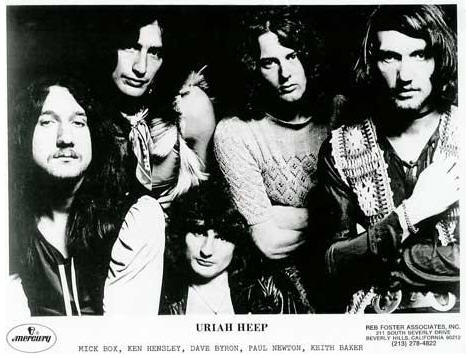URIAH HEEP STORY (original) (raw)

February 1970 - October 1970
Official Mercury Promo photos


Ken Hensley, David Byron, Paul Newton, Mick Box, Keith Baker.
Many more pics and snippets from Paul Newton's archive here
Ollie Olsson had defected back to the Elton John camp once again, in response to John's debut album taking off in the States, and had been replaced by Keith Baker.
Once again produced by Gerry Bron at Lansdowne,is significant for its songwriting development ( Hensley writes half and co-writes the other half), and for its diversity. First there's 'Bird of Prey', all climactic build up with lots of high notes from Byron, then the 'Lady in Black' single, an appropriately Euro-sounding ditty that subsequently became a gigantic hit in Germany upon its re-release in 1977, earning the band the Golden Lion award (the European equivalent of a Grammy) for its thirteen week stay at No. 1.
But ultimately the album's highlight is its title track, a 16 minute 22 second epic that represents a musical potpourri with its keyboards, brass, woodwind and orchestral parts, all creating a wealth of colour and substance as the track explores uncharted territory for the band at that point in time. It's possibly still the most musically ambitious thing that Heep have ever done.
The British press to a large extent remained deaf to the band's musical qualities, remaining preoccupied with the heavier side of their character. SALISBURY's diversity stems from a search to find a proper musical identity, though Hensley's later reflection that "all we knew in those days was that we wanted to play loud rock and roll music" is perhaps a little dismissive of the ambiances and nuances that made Heep stand out from the rest of the hard rock pack. Following SALISBURY it was Keith Baker's turn to leave the band.
"I never quite knew what happened to him." says Box, and the question of whether he spontaneously combusted in true Spinal Tap fashion is one that remains unanswered to this day.